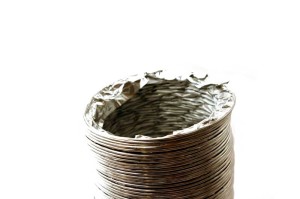The most common indicators of a clogged dryer vent are clothes that remain damp through the drying cycle, the absence of lint on the dryer screen, and a hot dryer. Your dryer should remain cool to the touch, so if it heats up, that hot air is trapped and not going anywhere. It is also not circulating, so your clothes are not being dried and you’re simply wasting electricity or gas.

This drag on the dryer’s efficiency is not, however, the best reason to deal with a clogged dryer vent. Safety is paramount, and if heated air is not removed from the house, that heat can be transferred to nearby framing materials. Moreover, the lint that is most likely clogging the vent duct is easily ignited and among the most common causes of house fires.
Even the best of intentions can go awry, and it is not unusual for a homeowner to damage the vent ducts while cleaning them. If they are made of flexible aluminum, they can easily be torn or ripped and the crack may go undetected until the dryer’s performance begins to lag. Aluminum ducting has no place in modern homes and needs to be replaced with a smooth surfaced metal.
A trained professional can replace aluminum ducts with metal ones, choosing the shortest path to the exterior of the house. This will improve the blow of the dryer and basically eliminate the accumulation of lint in bends and elbows. Every two years, the vent system should be thoroughly cleaned by a dryer vent professional.
Among other critical steps in a good cleaning, the hose will be detached from the dryer and the vent pipe will be inspected. Homeowners may find long lost jewelry and socks in the process, but of more importance is the assurance that lint has not accumulated in the pipe or elbow. Between professional dryer vent cleanings, homeowners need to keep the area around the dryer free of clutter and maintain adequate clearance between the dryer and the wall.

Recent Comments